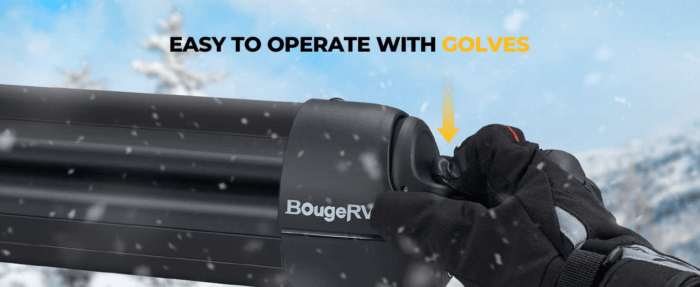
Ski season is an exciting time of year, whether you’re a seasoned pro or a weekend warrior. One essential piece of equipment that can often be overlooked is the ski rack for your car. Transporting skis and snowboards without a dedicated rack can be a hassle, and it can take up precious space inside your vehicle. With the right ski rack, your gear will be securely held in place, and you’ll have more room for passengers and other belongings.
In this article, we’ll explore the different types of ski racks for cars, including the popular hitch ski rack option. We’ll also discuss the advantages and considerations for each type, helping you decide which ski rack best suits your needs.
Why You Need a Ski Rack for Your Car
Transporting skis, snowboards, and other equipment without a dedicated rack can be a challenge. Not only do these items take up a lot of space inside the car, but they can also create visibility issues and even damage the interior of your vehicle. By using a proper ski rack, you can secure your gear safely outside the car, preventing it from moving around and potentially causing harm to passengers or equipment.
Ski racks free up space inside the car, making for a more comfortable ride, especially if you’re traveling with family or friends. Additionally, a dedicated ski rack reduces the risk of damaging your skis or snowboards. Without proper support, skis can be scratched, or bindings may be knocked loose during transit, which could affect their performance on the slopes.
Types of Ski Racks for Cars
There are two main types of ski racks: roof-mounted ski racks and hitch ski racks. Each has its own set of benefits, and the best choice will depend on your vehicle, how often you ski, and how much equipment you need to transport.
1. Roof-Mounted Ski Racks
Roof-mounted ski racks are one of the most traditional options for transporting skis and snowboards. These racks are mounted directly on the roof of the vehicle and hold the skis or snowboards in place with clamps or straps. Roof-mounted racks are a great choice for those who don’t mind lifting their gear onto the top of the car and have vehicles already equipped with roof rails or crossbars.
Advantages of Roof-Mounted Ski Racks:
- Maximized Space: Roof-mounted ski racks keep your skis and snowboards completely out of the car, freeing up interior space for passengers and other gear. This is especially useful if you have a smaller vehicle or need to pack a lot of equipment.
- Carrying Capacity: These racks can carry multiple pairs of skis or snowboards, making them ideal for families or groups who need to transport a lot of equipment at once.
- Versatility: Many roof-mounted racks can be used year-round for other purposes, such as carrying bikes or kayaks, making them a versatile addition to your vehicle.
Considerations for Roof-Mounted Ski Racks:
- Difficulty of Loading: One downside to roof-mounted ski racks is that they require you to lift your gear overhead to secure it in place. This can be difficult for some people, especially if your vehicle is taller, or you’re dealing with heavy snow conditions.
- Wind Resistance: Placing skis or snowboards on the roof can increase wind resistance, which may reduce fuel efficiency on long trips. It can also create wind noise during driving.
- Accessibility: Retrieving your gear from the roof after a long day on the slopes can be inconvenient, especially if you’re tired or in a rush to load up and head home.
2. Hitch Ski Racks
For those looking for a more accessible option, a hitch ski rack is an excellent alternative. These racks attach to the trailer hitch of your car and hold your skis or snowboards at the rear of the vehicle. Hitch ski racks are easy to load and unload because they are positioned closer to the ground, which means no heavy lifting required.
Advantages of Hitch Ski Racks:
- Ease of Use: One of the biggest benefits of a hitch ski rack is its accessibility. Because the rack is mounted at the rear of the vehicle, loading and unloading your gear is much easier compared to roof-mounted racks. This can be particularly helpful in icy or snowy conditions when you want to avoid standing on slippery ground to reach the roof.
- No Impact on Aerodynamics: Since hitch ski racks are mounted at the back of the vehicle, they don’t create the wind resistance or noise associated with roof-mounted racks. This can help improve fuel efficiency, especially on longer trips to your favorite ski destinations.
- Multi-Purpose Use: Many hitch ski racks are designed to carry not only skis and snowboards but also bikes in the off-season. This makes them a versatile year-round option for outdoor enthusiasts who enjoy multiple sports.
Considerations for Hitch Ski Racks:

- Vehicle Compatibility: To use a hitch ski rack, your vehicle needs to be equipped with a hitch receiver. If your car doesn’t already have one installed, you’ll need to factor in the cost and effort of adding a hitch.
- Rear Access: Hitch ski racks can make it more difficult to access the trunk or rear of your vehicle, as the rack will block the tailgate. Some racks come with a tilt or swing mechanism that allows you to move the rack out of the way when you need to open the back of the car.
- Capacity: While many hitch ski racks can carry multiple skis or snowboards, they may have a lower overall capacity compared to roof-mounted racks, depending on the specific model.
Choosing the Right Ski Rack for Your Car
When deciding between a roof-mounted ski rack and a hitch ski rack, there are several factors to consider:
- Vehicle Type: If your car has a hitch receiver, a hitch ski rack may be a more convenient option, as it’s easier to load and unload your gear. For vehicles with roof rails or crossbars, a roof-mounted rack might be a simpler and more cost-effective choice.
- Amount of Gear: If you regularly travel with multiple pairs of skis or snowboards, consider the capacity of the rack. Roof-mounted racks typically offer more space for large groups, while hitch racks may be better suited for smaller families or individuals.
- Ease of Use: If lifting skis or snowboards onto the roof is a concern for you, especially if you drive a taller vehicle, a hitch ski rack is likely the more convenient option. On the other hand, if you want to keep the back of your car clear for easy trunk access, a roof rack might be the better choice.
- Year-Round Versatility: For those who participate in multiple outdoor activities, consider a rack that can be used year-round. Hitch ski racks that convert to bike racks offer flexibility, while roof-mounted racks can often be adapted for different types of gear.
Conclusion
Both roof-mounted ski racks and hitch ski racks offer excellent solutions for transporting your skis and snowboards, and the right choice depends on your specific needs and preferences. Roof-mounted racks maximize space but require more effort to load, while hitch ski racks offer easy access and versatility. By considering your vehicle type, gear requirements, and how often you’ll be hitting the slopes, you can choose the ski rack that best enhances your winter adventures. No matter which option you go with, having a dedicated ski rack ensures your gear is safe, secure, and ready for your next trip to the mountains.










